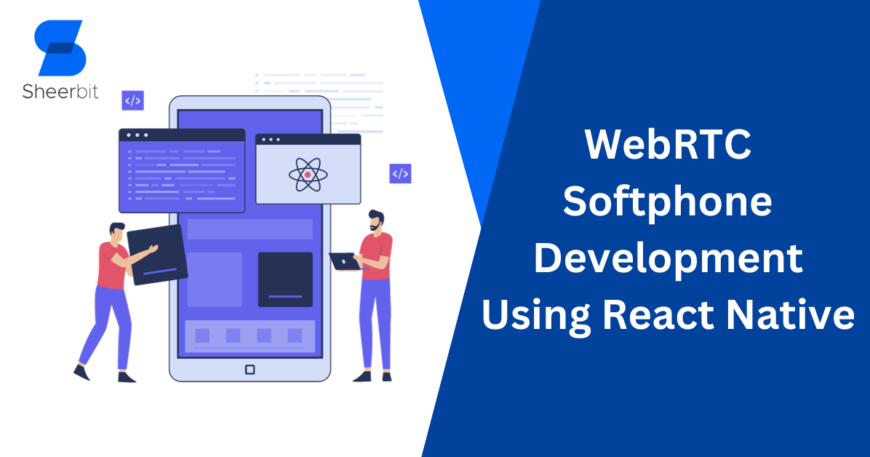Effective communication is essential for success in both personal and professional spheres in today’s fast-paced world. Businesses and developers are always looking for new and creative ways to meet the growing need for dependable, high-quality voice and video communication. This is the application of WebRTC technology. WebRTC is a popular option for creating softphones since it enables real-time audio and video communication within online and mobile apps. In this blog article, we will go into the fascinating realm of WebRTC Softphone Development, utilising React Native, a practical mobile application framework.
Chapter 1: Understanding WebRTC and Its Significance
WebRTC is an open-source project using straightforward JavaScript APIs to enable real-time communication between web browsers and mobile apps. It is a valuable option for developers since it does not need the installation of extra software or plugins. WebRTC provides several essential functionalities, such as:
- Audio and Video Calling: Developers may create apps that provide HD audio and video calls with WebRTC.
- Data Sharing: WebRTC may be used for much more than just softphones because it allows data transfer in addition to audio and video.
- Low Latency: Low-latency communication is guaranteed via WebRTC, resulting in a flawless user experience.
- End-to-end Encryption: WebRTC provides encrypted communication by default since security is paramount.
Chapter 2: The Power of React Native
A well-liked open-source framework for creating mobile applications with JavaScript and React is called React Native. It reduces the time and effort required to develop cross-platform apps by enabling developers to work with a single codebase. The creation of softphones is made possible by combining WebRTC and React Native.
- Cross-Platform Development: You may save time and costs using React Native to design softphones that function on iOS and Android platforms.
- Hot Reloading: Real-time real-time change visibility for developers expedites development.
- Large Developer Community: Because of React Native’s large developer community, materials and help are readily available.
- Native Performance: React Native ensures a seamless user experience by providing native-like performance.
Chapter 3: WebRTC Softphone Development Steps
Let’s now explore creating a WebRTC softphone with React Native.
Step 1: Set Up Your Development Environment
You must configure your development environment before you can begin writing code. Install the required tools, including React Native CLI and Node.js. Ensure that your system is prepared for the creation of mobile apps.
Step 2: Create a New React Native Project
To start a new project, use the React Native CLI. You can designate the project name and the platforms you wish to target (Android and iOS).
Step 3: Integrate WebRTC
To include WebRTC in your React Native app, you must install the required libraries and packages. Libraries like react-native-webrtc and react-native-incall-manager are often used for WebRTC integration.
Step 4: Implement User Authentication
In a Softphone User authentication mechanism is must. Firebase, AWS Cognito, or your favourite authentication provider may manage user login and registration.
Step 5: Implement Audio and Video Calling
To develop video and audio calling functionalities, use the WebRTC APIs. To create connections between users, signalling servers must be put up. Well-liked options for signalling servers include Firebase Real-time Real-time Database and Socket.io.
Step 6: Implement Additional Features
Add functionalities to your softphone, such as text messaging, call recording, contact management, and call history. To add these features, you can leverage third-party APIs and React Native frameworks.
Step 7: Testing and Debugging
Test your softphone extensively across a range of devices and network configurations. Fix any problems and enhance performance.
Chapter 4: Challenges and Solutions
Although creating a WebRTC softphone using React Native is fascinating, there are a few obstacles to overcome:
- Cross-Platform Compatibility: It might be challenging to ensure your softphone functions flawlessly on iOS and Android. It takes a lot of testing to find and fix platform-specific problems.
- Signalling Servers: Maintaining and configuring signalling servers may be difficult. To lessen this load, think about utilising managed services or cloud computing.
- Audio and Video Quality: Optimising codecs and network settings may be necessary to achieve high-quality audio and video conversations. It is essential to monitor and improve continuously.
- Security: Security is paramount, mainly when communicating in real-time. Make sure that when creating your softphone, encryption and security best practises were taken into account.
Chapter 5: Future Possibilities
The field of developing WebRTC softphones is constantly changing. The following are some fascinating prospects for the future:
- AR/VR Integration: Virtual reality (VR) and augmented reality (AR) can improve and intensify the softphone experience.
- AI Integration: Using artificial intelligence in features like voice commands, automatic answers, and speech recognition.
- WebRTC in the Browser: Adding WebRTC compatibility to web browsers may pave the way for future softphone developments and applications.
- Enhanced User Experience: It will be essential to develop user interfaces and user experience design continuously.
Conclusion
React Native’s cross-platform development capabilities and WebRTC’s real-time communication capabilities may work together to create creative and easy-to-use softphones that satisfy the rising need for contemporary communication solutions.
The options are unlimited, whether you’re a developer hoping to build your own softphone or an enterprise trying to incorporate WebRTC technology. To fully realise the potential of WebRTC softphones in the digital era, begin your development journey right now.
Together, let’s create the communication of the future! Please get in touch with us if you need help or if you have any queries about developing a WebRTC softphone. Our group of professionals is here to help you at every stage. Contact us immediately to leave your imprint on the WebRTC softphone development industry.





